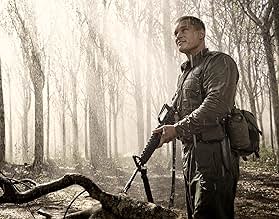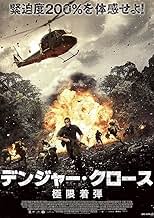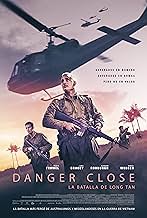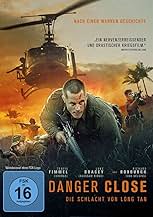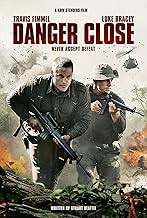En agosto de 1966, en una plantación de caucho vietnamita llamada Long Tan, 108 soldados jóvenes y en su mayoría sin experiencia que vienen de australia y nueva zelanda luchan por sus vidas ... Leer todoEn agosto de 1966, en una plantación de caucho vietnamita llamada Long Tan, 108 soldados jóvenes y en su mayoría sin experiencia que vienen de australia y nueva zelanda luchan por sus vidas contra 2500 soldados norvietnamita y Viet Cong soldados.En agosto de 1966, en una plantación de caucho vietnamita llamada Long Tan, 108 soldados jóvenes y en su mayoría sin experiencia que vienen de australia y nueva zelanda luchan por sus vidas contra 2500 soldados norvietnamita y Viet Cong soldados.
- Dirección
- Guionistas
- Elenco
- Premios
- 8 premios ganados y 6 nominaciones en total
- Gunner Murry Watene
- (as Richard Te Are)
Opiniones destacadas
And he is front and center again in this one. He has to make decisions that have impact on not just him and his crew, but many others. Now war movies are tough to watch - but if they are as well made as this one, they are also quite beautiful (and yes I'm aware of the irony, especially in this very vivid effort, that shows us the repercussions)! For some this may feel a bit over the top at places, but overall it does stay grounded. And has us in the middle of it all ... not for the faint of hearted for sure
During the battle of Long Tran, 108 Australian and New Zealand soldiers held off a North Vietnamese force of over 2000. 18 Australians and an estimated 245 Vietnamese lost their lives.
The terrain and the artillery pieces looked quite different as they are shown in the movie. Filming Locations: Village Roadshow Studios, Oxenford, Queensland, Australia. The SLR rifles looked real, but the M16s were not E-1s or E-2s; actually, the 16 rifles were not introduced to the Australian Army until 1967. You could use the flash suppressor of the E1 to break the bands on "c-ration" cases. I still have an AR15.
However, this is a movie, and it does not have to be factual. It is the people integration that makes or breaks this movie for the viewer. Oh, yes and there is a lot of action for those that like a lot of action.
Talking about action, we get an APC charge that looks like Tarzan and the elephants at the last minute. The only problem with that is that no one would be caught in an APC. We always rode on top (usually including the driver) as one good RPG shot would burn a good two-inch hole in the aluminum hull on its way through. I had to clean up body parts from an RPG that went through the driver and into the engine compartment taking a lot of drivers with it.
The U. S. military was not as professional at the time, but they were disciplined and not arrogant as the soldiers in this movie are portrayed.
You get to hear "These Boots Are Made for Walkin'" Artist: Nancy Sinatra Release year: 1966
"He's my Blond-Headed, Stompie-Wompie, Real Gone Surfer Boy" (1964) Emmy Dougall played the singer Little Pattie
Also, you get to hear "I was only 19 (a Walk in the Light Green)" by John Schumann.
In memory of those members of D COY and 3TP IACP Sqn who gave their lives during the Battle of Long Tan on 18th August 1966.
To make the movie entertaining they added fictional characters and incidents.
Be sure to watch the credits.
Our small number of troops had no fighting experience in the terrain and climate of south east asia. Our government instated conscription to find the troop numbers it was tasked with sending, in support of the U.S., New Zealand, and a handful of developing anti-communist asian countries. North Vietnam (communist Viet Cong) were well equipped by the U.S.S.R. and China, and knew their battle ground well. This battle of Long Tan story isn't a turning point in the war. It is a frightening reality of how close fragile human beings are to catastrophe when battlefield circumstances quickly change.
Stenders executes the story with a firm, professional hand from the outset. Ben Nott's camera work thoroughly enhances the atmosphere, character development and storyline. Visual and special effects were seriously well embedded in the action. Production values are excellent throughout. Sound and editing also deserve a special mention. While I felt he stunts got off to a slow start, once the director and cameraman found their stride, the impact of the firefights was ferocious and all too believable. This was no mean feat. A good two thirds of this movie is from the POV of young conscripts, pinned under heavy fire, surviving and surrounded by exploding artillery. Stenders manages to keep us sufficiently connected to the characters amid this deadly chaos, without resorting to usual battlefield cliche's. The result is gripping, and at times heartbreaking. And, much to Stenders credit, there isn't a wasted frame.
There are a lot of good performances rung in in this movie. Travis Fimmel nails his Majory Harry Smith role and captures the screen. This fella can act, and he knows what he gives the camera. He imbues each scene with appropriate weight and intensity. Richard Roxburgh is at the peak of his film acting powers in this one. He could have made his antagonistic Brigadier Jackson into a two dimensional character and gotten away with it. But he, too, shows his craft. He provides us solid glimpses of Jackson's conflict and humanity, trapped beneath the institution of his command.
I've said this in other reviews, and it holds true for this one. The supporting cast is uniformly good. I'm leaving many names out here that should be included, but just peruse the cast list for those not mentioned. They all equally deserve to be. Daniel Webber as the fresh faced Private Large, Nicholas Hamilton's Private Grimes,Mojean Aria's Second Lieutenant Gordon Sharp, Stephen Peacocke, Luke Bracey, Myles Pollard and Uli Latukefu, who stole scenes amid firing field artillery, show how well directed this movie is, and how much this story meant to the actors. That there was room in this film to lend the enemy a more human face is a small criticism given what is acheived. The battle of Long Tan was a frightening punctuation point in our history. While Stender's film reveals itself a study of courage under fire, it has taken Australia decades to fully understand the cost of sending these19, 20, 21 year old conscripts into battle. I hope we learn from history, this lesson is never to be repeated.
¿Sabías que…?
- TriviaThe term, "Roger that", is an Americanism, originally from CB radio culture, and often used in military movies. However, it would never be said (or permitted, by any NCO or Officer within earshot) in the Australian Army. "Roger" is the only accepted proword. Similarly, the phrase, "I repeat", when repeating some for clarity over the radio telephone (RATEL), is not permitted. Instead the operator would use, "I say again...". This is because "repeat" is a proword used when directing artillery or naval fire (e.g "request for the same volume of fire to be fired again with or without corrections or changes")
- ErroresThe entire battle took place in a torrential tropical downpour from start to finish. Evidently, this would be hard to film for dramatic purposes. The airstrike never happened not because of a dud smoke grenade, but the cloud was so low and rain so intense the pilots could not identity the target area.
- Citas
Major Harry Smith: There's a thousand ways to die in a war zone.
- Créditos curiososPart way through the final credits, after showing the actors and pictures of their real life counterparts and some of the principal credits, acknowledgment of the 6RAR's Presidential Unit Citation from the USA made in 1968 but that Australia took 45 years to acknowledge the soldiers who fought in a similar way.
This is followed by an Honour Roll of the Australian Soldiers killed during this battle.
- ConexionesFeatured in Danger Close: Behind the Scenes (2019)
Selecciones populares
- How long is Danger Close?Con tecnología de Alexa
Detalles
Taquilla
- Presupuesto
- AUD 24,000,000 (estimado)
- Total a nivel mundial
- USD 2,092,198
- Tiempo de ejecución
- 1h 58min(118 min)
- Color
- Relación de aspecto
- 2.35 : 1






